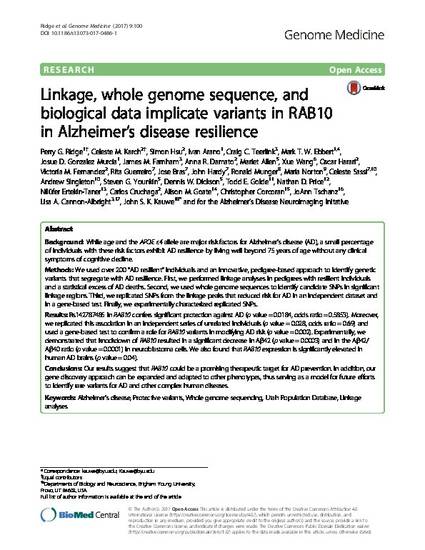
Background
While age and the APOE ε4 allele are major risk factors for Alzheimer’s disease (AD), a small percentage of individuals with these risk factors exhibit AD resilience by living well beyond 75 years of age without any clinical symptoms of cognitive decline. Methods
We used over 200 “AD resilient” individuals and an innovative, pedigree-based approach to identify genetic variants that segregate with AD resilience. First, we performed linkage analyses in pedigrees with resilient individuals and a statistical excess of AD deaths. Second, we used whole genome sequences to identify candidate SNPs in significant linkage regions. Third, we replicated SNPs from the linkage peaks that reduced risk for AD in an independent dataset and in a gene-based test. Finally, we experimentally characterized replicated SNPs. Results
Rs142787485 in RAB10 confers significant protection against AD (p value = 0.0184, odds ratio = 0.5853). Moreover, we replicated this association in an independent series of unrelated individuals (p value = 0.028, odds ratio = 0.69) and used a gene-based test to confirm a role for RAB10 variants in modifying AD risk (p value = 0.002). Experimentally, we demonstrated that knockdown of RAB10 resulted in a significant decrease in Aβ42 (p value = 0.0003) and in the Aβ42/Aβ40 ratio (p value = 0.0001) in neuroblastoma cells. We also found that RAB10 expression is significantly elevated in human AD brains (p value = 0.04). Conclusions
Our results suggest that RAB10 could be a promising therapeutic target for AD prevention. In addition, our gene discovery approach can be expanded and adapted to other phenotypes, thus serving as a model for future efforts to identify rare variants for AD and other complex human diseases.
Available at: http://works.bepress.com/joann_tschanz/63/
